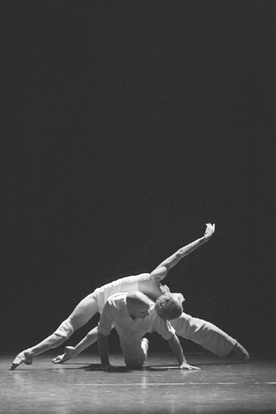“PUSH” inaugurates a New York/London dialogue
Ballerina Sylvie Guillem and choreographer Russell Maliphant, both former Sadler’s Wells Royal Ballet dancers, brought a program of four new works to City Center October 11-15. The dances, two made ten years ago and two from ’05, collectively called “PUSH,” celebrate the body and intrigue the mind.
Maliphant took to modern, and Sadler’s Wells itself is now a hotbed of contemporary dance. “PUSH” is an exchange with the London theater—they will get the City Center Fall For Dance.
A Balanchine duet, however neoclassical, leaves us with romantic poetry. For Maliphant, two bodies create form, which is visualized through the artful lighting of Michael Hulls and abetted by the music. Energy ripples through body parts and from one dancer to the other with a physicality that moves us.
After seeing the Ballet Boyz in Maliphant’s “Torsion” I was skeptical about the relevancy of pure dance. Erik Satie’s “Gymnopédies” will never die. “PUSH” offers similar mystery, and masterful craft.
Guillem is an amazingly limber and assured 41-year-old dancer. She started as a gymnast before rising to stardom as Nureyev’s étoile dancer in the Paris Opera Ballet. She’s come full circle to the modern works of Maliphant, with handstands, flips, and tumbles. Her port de bras explode into something different, deconstructed yet utterly crucial underpinnings of the movement.
In the first “Solo,” Guillem’s form is the subject, seen through diaphanous loose fitting whites and bathed in first yellow then blue light to Carlos Montoya’s steely Spanish guitar music. Most notably her curvaceous arms draw us in to “PUSH.” Both music and dance end abruptly, tantalizing. We see that looking away for even a brief moment isn’t an option.
“Shift” interestingly pairs Maliphant with larger than life shadow images of him, moving naturally in unison with the centerdness of martial arts. First one, then two, then three. They magically exit through openings in the bright pale yellow backdrop. A string composition by pioneering black composer Shirley Thompson perfectly matches the movement’s balance of ethereal and earthy.
Maliphant’s one raised arm leads him in a spin. His arm swings down. He turns finally owning and chasing his shadow. The shadows follow his dance that is stripped to the essential—to an Asian timbre in Thompson’s melody. Maliphant bids goodbye to his partners bending backwards to embrace one shadow standing just behind him. They all come out for bows.
The ‘how did he do it’ factor amuses and the humor prepares us for the dramatic “Two.” Guillem in black backless dress bends forward almost to the floor letting her arms create shapes. Hull’s warm glow lights only the bare parts of her body and her back is a form with round edges recalling Edward Weston’s photos of nudes and peppers. Guillem’s endless appendages pivot from her center line, a mass of curves and unfolding angles, to a rumble of bass from Andy Cowton’s apt score. Her port de bras gain centrifugal force and her arms windmill to the rock beat with a life of their own, pulling the light down around her. Spectacularly, but in the blink of an eye, a flash of follow spot catches her just before black out. Exhilarating.
The final “Push” is like a bedtime story, poignant but quiet, to tinkling watery sounds and vocals in Cowton’s score. On Maliphant’s shoulders in short skirted white leotard and knee pads, they drop down and turn near the floor, ending this challenging phrase sitting side by side. Lights cut off gently dividing phrases of slow fluid movement. She is straddled on his shoulder, then flipped over, her long legs stretch up. Resting in playful tango mode, twirling arms create accents to trance piano and percussion. Lying across his shoulders, her legs impossibly languish to the side, seeming to defy gravity. It’s as if a sphinx has stretched out before our eyes. It’s not just Guillem that Maliphant celebrates, it’s the body beautiful.
gaycitynews.com


































